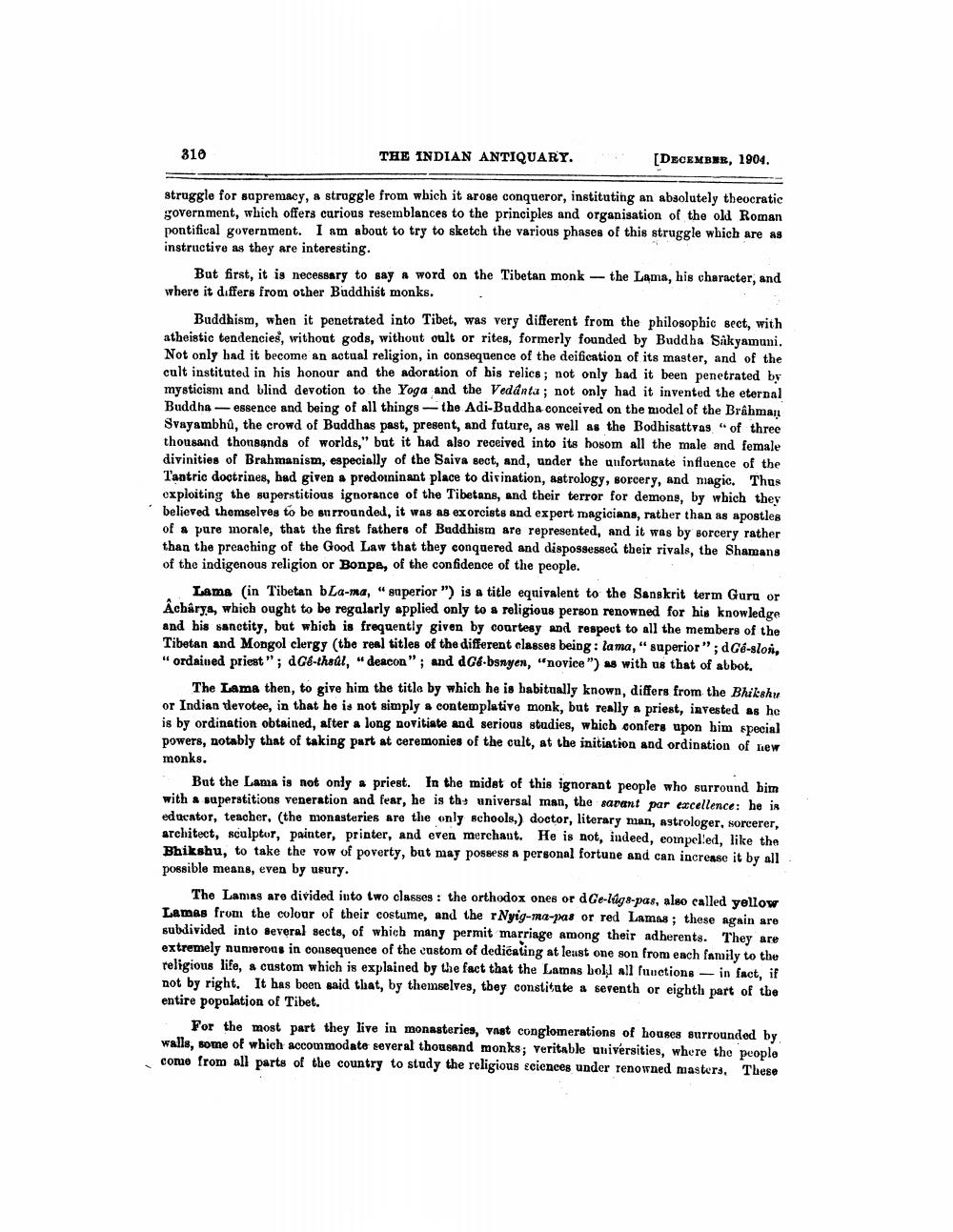________________
310
THE INDIAN ANTIQUARY.
[DECEMBER, 1904.
struggle for supremacy, a struggle from which it arose conqueror, instituting an absolutely theocratic government, which offers curious resemblances to the principles and organisation of the old Roman pontifical government. I am about to try to sketch the various phases of this struggle which are as instructive as they are interesting.
But first, it is necessary to say a word on the Tibetan monk - the Lama, his character, and where it differs from other Buddhist monks.
Buddhism, when it penetrated into Tibet, was very different from the philosophic sect, with atheistic tendencies, without gods, without oult or rites, formerly founded by Buddha Sikyamuni. Not only had it become an actual religion, in consequence of the deification of its master, and of the cult instituted in his honour and the adoration of his relics; not only bad it been penetrated by mysticism and blind devotion to the Yoga and the Vedanta ; not only had it invented the eternal Buddha - essence and being of all things - the Adi-Buddha conceived on the model of the Brahman Svayambhủ, the crowd of Buddhas past, present, and future, as well as the Bodhisattvas of three thousand thonsands of worlds," but it had also received into its hosom all the male and female divinities of Brahmanism, especially of the Saiva sect, and, under the unfortunate influence of the Tantric doctrines, had given a predominant place to divination, astrology, sorcery, and magic. Thus exploiting the superstitious ignorance of the Tibetans, and their terror for demons, by which they believed themselves to be surrounded, it was as exorcists and expert magicians, rather than as apostles of a pure morale, that the first fathers of Buddhism are represented, and it was by sorcery rather than the preaching of the Good Law that they conquered and dispossessed their rivals, the Shamans of the indigenous religion or Bonpe, of the confidence of the people.
Lama (in Tibetan bLa-ma, "superior ") is a title equivalent to the Sanskrit term Guru or Acharya, which ought to be regularly applied only to a religious person renowned for his knowledge and his sanctity, but which is frequently given by courtesy and respect to all the members of the Tibetan and Mongol clergy (the real titles of the different classes being : lama," superior"; Gé-sloni, " ordained priest"; dC8-thodl, "deacon"; and dCé-bsnyen, "novice ") as with us that of abbot.
The Lama then, to give him the title by which he is habitually known, differs from the Bhikshu or Indian devotee, in that he is not simply a contemplative monk, but really a priest, invested as he is by ordination obtained, after a long novitiate and serious studies, which confers upon him special powers, notably that of taking part at ceremonies of the cult, at the initiation and ordination of liew monks.
But the Lama is not only priest. In the midst of this ignorant people who surround him with a superstitions veneration and fear, he is th: universal man, the savant par excellence: he is educator, teacher, (the monasteries are the only schools,) doctor, literary man, astrologer, sorcerer, architect, sculptor, painter, printer, and even merchant. He is not, indeed, cornpelled, like the Bhikshu, to take the vow of poverty, but may possess a personal fortune and can increase it by all possible means, even by usury.
The Lamas are divided into two classes : the orthodox ones or dGe-lúg8-pas, also called yellow Lamas from the colour of their costume, and the rNyig-ma-pras or red Lamas; these again are subdivided into several sects, of which many permit marriage among their adherents. They are extremely nunerous in consequence of the custom of dedicating at least one son from each family to the religious life, a custom which is explained by the fact that the Lamas boll ull functions -- in fact, if not by right. It has been said that, by themselves, they constitute a seventh or eighth part of the entire population of Tibet.
For the most part they live in monasteries, vast conglomerations of houses surrounded by walls, some of which accommodate several thousand monks; veritable universities, where the people come from all parts of the country to study the religious sciences under renowned masters. These




